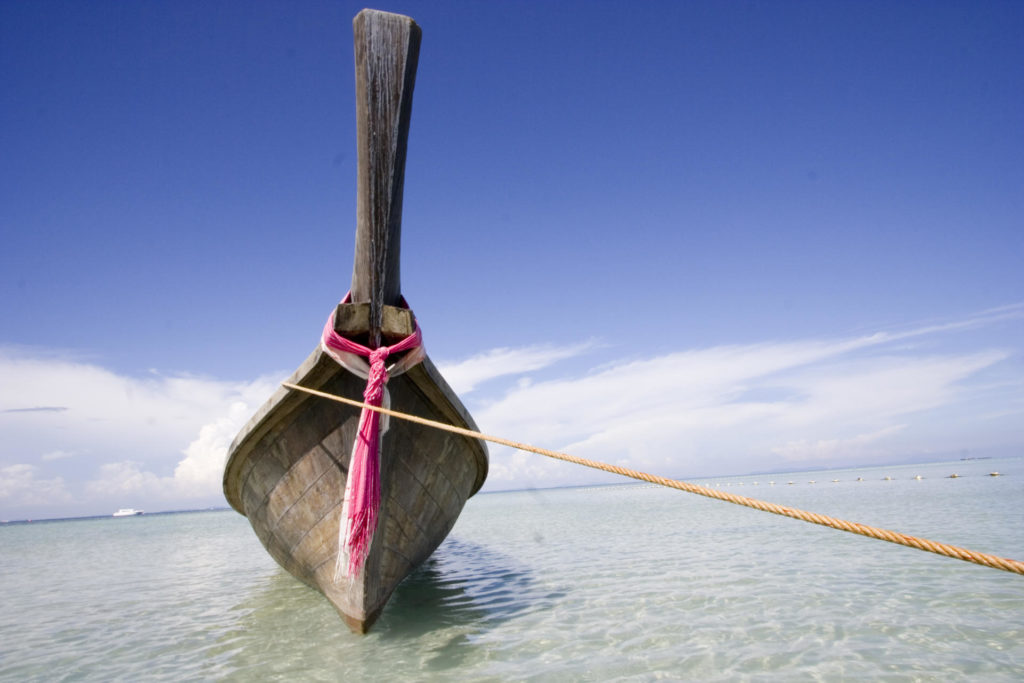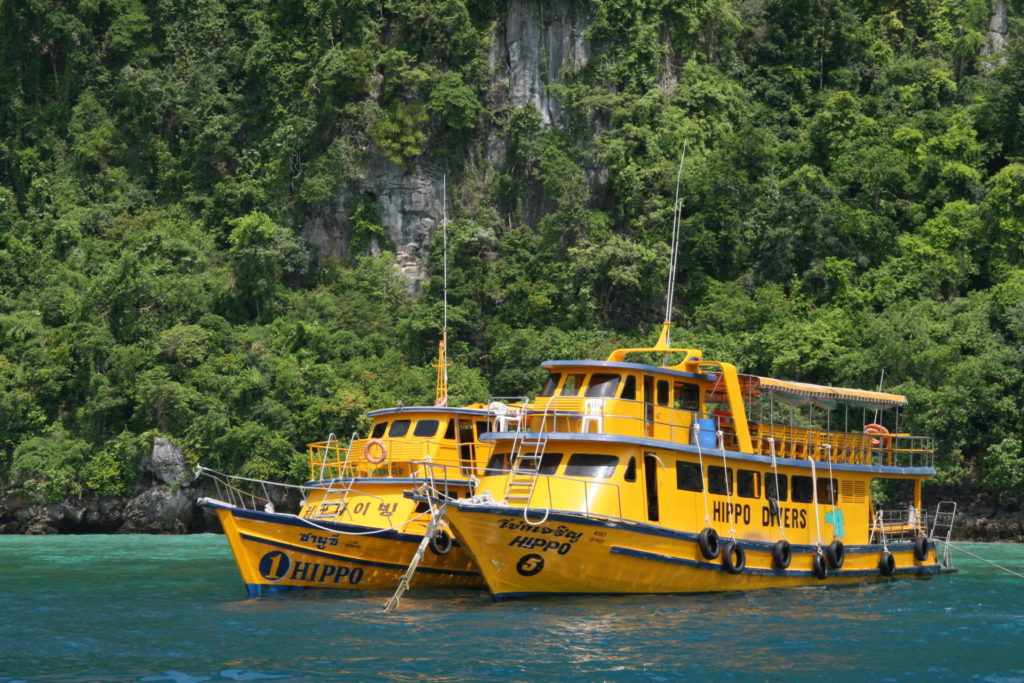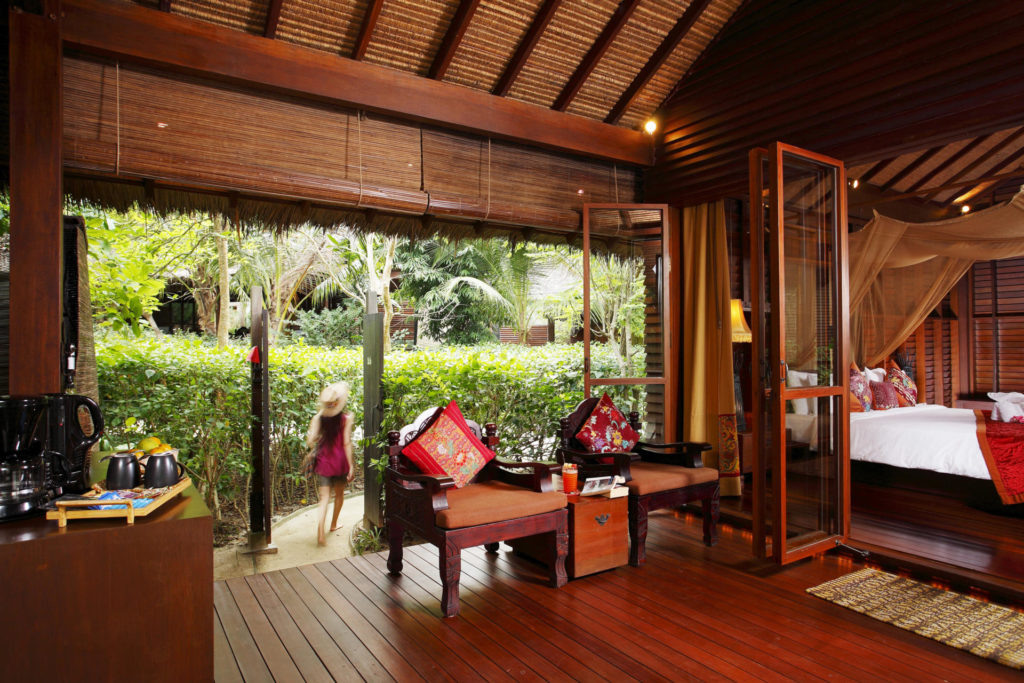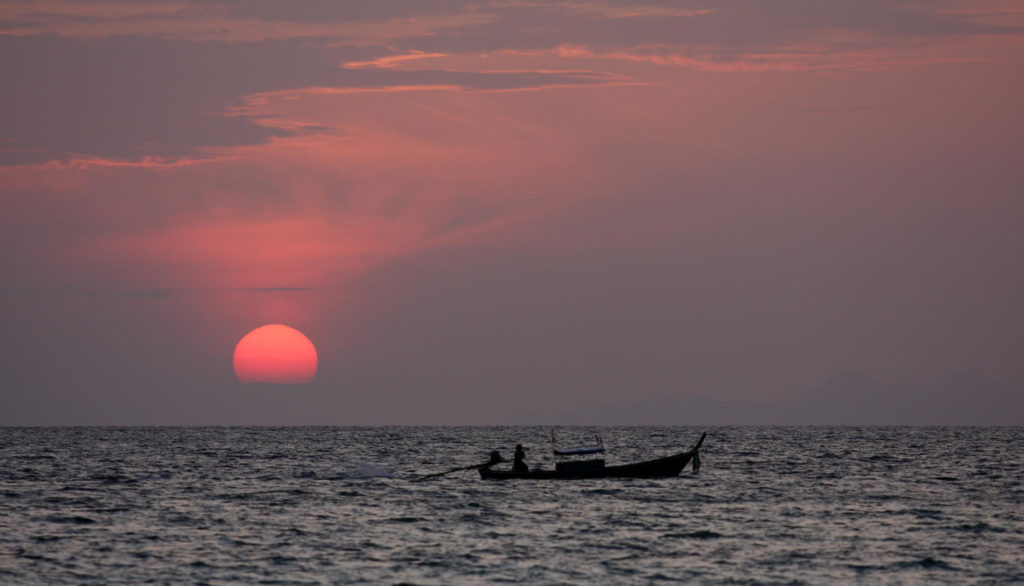
The name Zeavola comes from the Latin name for the half flower tree, called rak talay in Thai, meaning “lover of the sea.” For generations, sea loving nomads have hopped from island to island in the Andaman Sea. Today, some have taken residency on Phi Phi Don, often referred to as “Phi Phi,” the largest island in Thailand’s Krabi Province and the only one with permanent residents. These sea gypsies can make more selling their fish to tourist restaurants here than at the markets in Krabi and there is steady work taxiing tourists around the islands.
Laem Tong Beach is on the quiet northeast corner of Phi Phi Don, near the five-star Zeovola resort. Here, there are a couple sea gypsy villages, where ropes lead out from the shore to long-tailed boats waiting for guests who want a ride down to Ton Sai, the lively town center of the island.
On one side of Ton Sai the speed boats, ferries and dive boats are anchored or docked. A short walk across a flat stretch of land, just two meters above sea level, is the main beach, littered with sun worshipers and travelers enjoying hot days and long nights. In between, narrow streets are packed with souvenir shops, restaurants, bars, dive shops and cheap accommodation catering to the shoestring crowd; mostly young people enjoying short escapes or long journeys until they have to go back to school or work.

Ton Sai’s a nice place to visit, but I wouldn’t want to stay there. The more peaceful northern tip of the island is just a 15-20 minute long-tail ride, so it’s easy to get your fill of music and fire dancing and then retreat to the rhythms of the jungle. Luckily the best green curry can be found up on Laem Tong Beach at the Jasmine Restaurant. Run by Peter, a friendly Scotsman, and his wife Tak, this no frills restaurant serves big portions of delicious Thai food, tasty mojitos and a portion of your bill goes to support the local school.
I was digging my toes into the sand here when Peter and I started up a conversation. Discovering I was traveling from Japan, we soon found ourselves talking about the recent tsunami in Japan, drawing parallels to the devastating one that hit Phi Phi less than a decade ago.
On Boxing Day (Dec. 26) 2004, the tranquil Andaman Sea turned terrifying. A massive undersea earthquake off the coast of Sumatra triggered a series of devastating tsunami that would strike nearly every land mass in the Indian Ocean, Phi Phi included.
“When the wave hit Phi Phi it wrapped around the island,” Peter recalls, “so when it came around it actually hit Ton Sai from both sides.”
On that fateful day, Peter was on another island, Koh Lanta. “The tsunami wave carried me about 350 meters, but luckily I was able escape,” he says.
Peter lost 18 friends that day.
Admittedly, Koh Phi Phi wasn’t prepared for a disaster of this magnitude. There was no Early Warning System (EWS) and information was scarce on what to do in case of emergency. Of the roughly 8,000 people working or enjoying their winter holiday on the island that day, a quarter were reported killed or missing.
Today there are signs in many places of the island showing evacuation routes to safe ground as well as a network of EWS stations in place to warn people on the island of any potential danger. Considering all the infrastructure was destroyed on Koh Phi Phi, it’s encouraging to see how the island and the people have bounced back. Ton Sai is once again packed with travelers and hedonistic revelers, an armada of boats hit the water each morning for island hopping trips to Phi Phi Leh, the infamous setting for the movie The Beach, or to explore the many great dive sites.
Due to the geography of Phi Phi Don, Laem Tong Beach was mostly spared and so too were the sea gypsies. Many of their boats and nets were damaged or destroyed, however, and so their livelihood. Since then, boats have been repaired or replaced and life is much as it was before, with a few new developments.
One of which is Zeavola. This natural resort opened in 2005 despite the fact tourism had recently taken a major hit. General Manager Florian Hallermann said they thought it was important to open as planned and show their commitment to the island as the community was pulling together.

The hard work has paid off. Zeavola has the charms of a rural village, with meandering sandy paths you can stroll barefoot along to private teakwood villas set back into the beach. Hillside villas have awesome Andaman views of nearby islands and you’ll fall asleep to the sounds of nature without a worry in the world.
With time, history fades, yet Boxing Day 2004 has not been forgotten on Phi Phi. Locals seem more vigilant than before, and steps have been taken to make sure past mistakes will not be repeated. Yet as we have learned here in Japan, no place is perfect, no place totally safe. Visitors have returned to Phi Phi knowing that with life there is risk, but without risk there is no living. They return because they love to travel and they love this island, and Japan should take comfort in this.
Zeovola
www.zeavola.com
Zeavola Resort can arrange a private speedboat to and from Phuket or Krabi that takes just an hour, but occasionally, if the sea is too rough, you can jump the public ferry which takes 3 hours 45 minutes.





